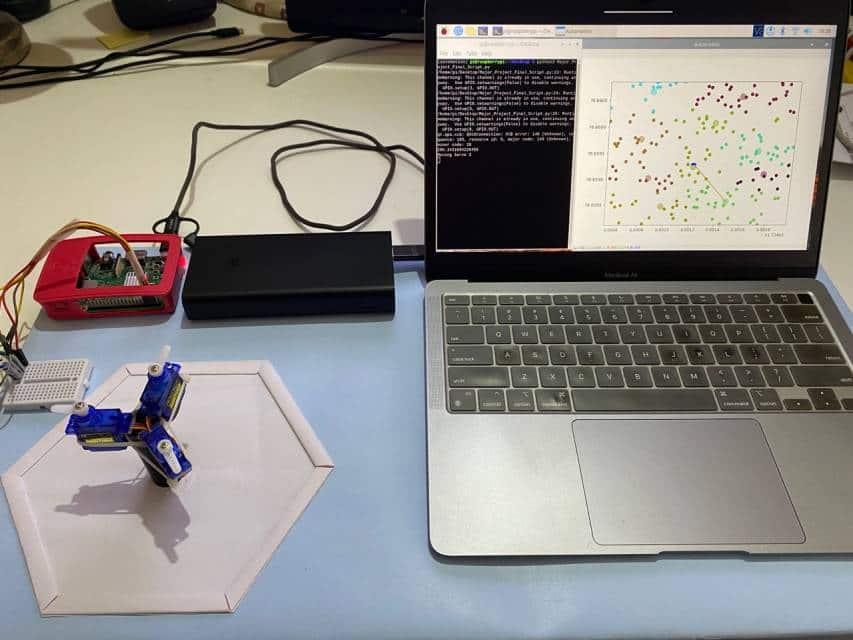



Have you ever been in a crowded, public place, trying to connect a crucial phone call, but kept experiencing call drops? Niranjan Akella, a 22-year-old engineering graduate, is trying to solve this pesky problem with a software.
Akella created an artificial intelligence-based software to solve the issue of call drops in crowded locations with his classmates as the final-year project of his engineering course at Guru Nanak Institutions Technical Campus in Ibrahimpatnam, Telangana, and has now filed for a patent.
How the software worksThe AI-based software, which studies cluster patterns (population patterns) is installed at the base transmitter. A motorised apparatus fitted to the antenna realigns its position, based on data provided by the software over a period of 10 or more days, helping it provide the best possible coverage.
The students built a prototype of the software and tested it using miniature models of servomotors on a Raspberry Pi computer. A Raspberry Pi is a single-board computer designed to teach programming skills, build hardware projects, do home automation, and so on.

Unable to get their hands on actual data on population patterns, Akella and his team generated random clusters through another AI-based software. They then found the centre of those clusters to see where the antenna needed to be targeted.
What inspired AkellaSitting in an Internet of Things (IoT) class, Akella was inspired to create the software when his professor explained how signal receptivity issues, to date, are solved manually, with little automation.
“I felt automation and AI can play a major role in the process, reducing human intervention,” Akella told Moneycontrol from his home in Hyderabad, during a virtual interaction.
He later shared the idea — technically called optimisation of cellular antenna orientation based on cluster strength, using an AI system — with his classmates and professors.
Akella’s idea was shot down. One of the reasons given was that he was a student of the Electronics and Communication Engineering stream — AI is seen more as the domain of those majoring in Computer Science. Others Akella spoke to also felt the cluster mechanism might not work.
"The world is all about saying this is not possible, and you can’t do it. The most important thing in your life is your imagination, and then your dedication to make it a reality,” he said.
Akella took it as a challenge to make his vision a reality. With the help of his professor and mentor Dr Rashid Mahmood and his closest friends Arumalla Koushik Reddy, Yeseswi Sree Neeli, and Bachu Sai Nikheel, he worked on the project and was able to build a successful prototype.
They eventually filed for a patent with the Office of the Controller General of Patents, Designs & Trade Marks. The patent application has now been published, but is pending examination.
What next?Whether the software can indeed resolve the call drop issue, will only be known after it has been researched and implemented on a larger scale.
Akella said he is currently looking for incubation and funding to implement the idea on a larger scale.
He added that he has received a call from the Department of Telecommunications (DoT), which has offered to support the team in developing the idea for the telecom sector, through the Telecom Technology Development Fund, which comes under the DoT’s Universal Service Obligation Fund.
“We are looking forward to incubation from the DoT. And we are also looking forward to some good research labs in IITs and IISC that have proper communication sectors,” said Akella. He added the team is now in early talks with telecom operators such as Jio to take the software to the market.
The team has more ideas, including developing the software further for locations with lower populations. “We are building another kind of AI for areas that are not as populated but still need coverage since communication is the basis for everything today,” added Akella.
India and call dropsCall drops have become a major issue in India, with most people today having a mobile device, which is increasing the density of usage. This has shot up the workload of the mobile towers in the country.
Minister for Communication & Electronics and Information Technology Ashwini Vaishnaw spoke about the issue recently, stating that the government is looking into the severity of the call-drop problem.
Experts believe while the software might solve a part of the problem, call drops are a result of multiple factors, which the software alone cannot solve.
“I think the software can be effective but to a limited extent, as call drops are caused due to multiple reasons besides the issue of capacity. No single solution of this kind is going to be enough,” said Mahesh Uppal, director of Com First, a niche consultancy specialising in communications, broadcasting, and other related areas.
Brimming with ideasAkella and his team graduated in July. They say they are open to keep building solutions for the telecom sector and have more ideas in the bank.
Akella’s other software work includes a remote coding mechanism for a minor project during his engineering course. “Wireless coding mechanism means I sit here and I code on some other unit, which is at some other place far away, just using Wi-Fi modules. It was pretty cool and it also became a sensation on the campus,” said Akella.
A trained Carnatic classical musician, Akella has also co-authored a book titled Convective Cell Tracking through Deep Learning-based Computer Vision, based on his research as a remote project student for the Indian Space Research Organisation, under Dr K V Subramanyam, a scientist-engineer at the Vikram Sarabhai Space Centre.

Discover the latest Business News, Sensex, and Nifty updates. Obtain Personal Finance insights, tax queries, and expert opinions on Moneycontrol or download the Moneycontrol App to stay updated!
Find the best of Al News in one place, specially curated for you every weekend.
Stay on top of the latest tech trends and biggest startup news.